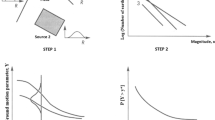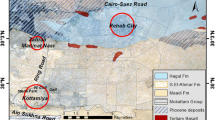Abstract
The seismic hazard for the Lake Van basin is computed using a probabilistic approach, along with the earthquake data from 1907 to present. The spatial distribution of seismic events between the longitudes of 41–45° and the latitudes of 37.5–40°, which encompasses the region, indicates distinct seismic zones. The positions of these zones are well aligned with the known tectonic features such as the Tutak-Çaldıran fault zone, the Özalp fault zone, the Gevaş fault zone, the Bitlis fault zone and Karlıova junction where the North Anatolian fault zone and East Anatolian fault zone meet. These faults are known to have generated major earthquakes which strongly affected cities and towns such as Van, Muş, Bitlis, Özalp, Muradiye, Çaldıran, Erciş, Adilcevaz, Ahlat, Tatvan, Gevaş and Gürpınar. The recurrence intervals of M s ≥ 4 earthquakes were evaluated in order to obtain the parameters of the Gutenberg–Richter measurements for seismic zones. More importantly, iso-acceleration maps of the basin were produced with a grid interval of 0.05 degrees. These maps are developed for 100- and 475- year return periods, utilizing the domestic attenuation relationships. A computer program called Sistehan II was utilized to generate these maps.







Similar content being viewed by others
References
Ambraseys N (2001) Reassessment of earthquakes, 1900–1999, in the Eastern Mediterranean and the Middle East. Geophys J Int 145:471–485
Ambraseys N, Jackson JA (1998) Faulting associated with historical and recent earthquakes in the Eastern Mediterranean region. Geophys J Int 133:390–406
Arpat E, Saroğlu F, Iz HB (1976) Çaldıran Earthquake, Yeryuvarı ve Insan 1977 2:29–41
Beyaz T (2004) Development of a new attenuation relationship of seismic energy for Turkey using the strong motion records free of soil effect. Ankara University, PhD Thesis, 2004 Ankara
Bolt BA (1989) The nature of earthquake ground motion. In: Naeim F (ed) The seismic design handbook. Van Nostrand Reinhold, NY
Bozkurt E (2001) Neotectonics of Turkey—a synthesis. Geodinamica Act 14:3–30
Çiftçi Y, Selçuk L, Özvan A, Akkaya İ, Şengül A, Bülent A (2004) Seismic risk analysis for the settlement in the basin of Lake Van. 5th International Symposium on Easternmediterranen Geology, Thessaloniki, Greece
Cornell CA (1968) Engineering seismic risk analysis. Bull Seism Soc Am 58:1583–1606
DAD (2007) Earthquake Research Department of Gen. Direct. of Disaster Affairs of the Ministry of Public Works and Settlement 2007. http://www.deprem.gov.tr
Dewey JF, Hempton MR, Kidd WSF, Şaroğlu F, Şengör AMC (1986) Shortening of continental lithosphere: the neo-tectonics of Eastern Anatolia—a young collision zone; Collision Tectonics. Geol Soc Special Publ 19:3–36
Erdik M, Doyuran V, Gu¨lkan P, Akkas N (1985) A probabilistic assessment of the seismic hazard in Turkey. Tectonophysics 117:295–344
Gardner JK, Knopoff L (1974) Is the sequence of earthquakes in southern California, with aftershocks removed, Poissonian? Bull Seismol Soc Am 64:1363–1367
Gülkan P, Kalkan E (2002) Attenuation modelling of recent earthquakes in Turkey. J Seismol 6:397–409
Gülkan P, Kocyigit A, Yucemen MS, Doyuran V, Basoz N (1993) Earthquake zoning map of Turkey based on most recent data: METU Earthquake Engineering Research Center, Report No. 93-01, 156 pp (in Turkish)
Gutenberg B, Richter CF (1944) Frequency of earthquakes in California. Bull Seismol Soc Am 34(4):1985–1988
Idriss IM (1990) Response of soft soil sites during earthquakes, proceedings, H. Bolton Seed Memorial Symposium, Bitech Publishers, Vancouver, British Columbia 2:273–289
Jackson J, McKenzie DP (1984) Active tectonics of the Alpine- Himalayan belt between western Turkey and Pakistan. Roy Astron Soc Geophys J 77:185–264
Joyner WB, Boore DM (1988) Measurement, characterization and prediction of strong ground motion. Earthq Eng Soil Dyn 2:43–102
Kalafat D (2002) Empirical quantification of earthquake magnitudes in seismic belts: Abstracts of Active Tectonic Research Group of Turkey Workshop (ATAG-6), MTA, Ankara, 105–108 (in Turkish)
Kayabalı K (2000) Sistehan II: a computer program for seismic hazard analysis. Geosound 37:15–42
Kayabalı K (2002) Modeling of seismic hazard for Turkey using the recent neotectonic data. Eng Geol 63:221–232
Ketin İ (1977) Short explanation for geological prospections between Van Lake and Iran Border. Bull Geol Soc Turkey 20:79–85
Koçyiğit A (1985) Karayazı Fault. Geol SocTurkey Bull 28:67–72
Koçyiğit A (2002) Neotectonics and seismicity of East Anatolian.Workshop-2002 on the Geology of East Anatolian. Van, Turkey
Koçyiğit A, Yılmaz A, Adamia S, Kuloshvili S (2001) Neotectonics of East Anatolian Plateau (Turkey) and Lesser Caucasus: implication for transition from thrusting to strike-slip faulting. Geodynamic Acta 14:177–195
Kramer SL (1996) Geotechnical earthquake engineering. Prentice Hall, NJ
Lemcke G (1996) Pala oklimarekonstruktion am Van See (Ostanatolien, Turkei). Dissertation, Swiss Federal Institute of Technology (Zurich) 11786:182
McKenzie D (1972) Active tectonics of the Mediterranean region. Geophys J R Astron Soc 30:109–185
Şaroğlu F, Güner Y (1981) Doğu Anadolu’nun jeomorfolojik gelişimine etki eden opener; jeomorfoloji, tektonik, volkanizma ilişkileri. Turkish Geol Bull 24:39–51 (in Turkish)
Şaroğlu F, Yılmaz Y (1986) Geological evolution and basin models in neo-tectonic period in Eastern Anatolia. Miner Res Explor Inst Turkey Bull 107:74–94
Şaroglu F, Emre O, Kuscu I (1992) Active fault map of Turkey. General directorate of mineral and research exploration of Turkey Publication
Schweizer G (1975) Untersuchungen zur Physiogeographievon Ostanatolienund Nordwestiran. Geomorphologische, klima- und hydrogeographischeStudien im Vansee- und Rezaiyehsee-Gebiet. Tubinger Geographische Studien 60
Selçuk L, Çiftçi Y (2007) Microzonation of the plio-Quaternary soils: a study of the liquefaction risk potential in the Lake Van Basin, Turkey. Bull Eng Geol Env 66(2):161–176
Şengör AMC, Görür N, Şaroğlu F (1985) Strike-slip faulting and related basin formation in zones of tectonic escape: Turkey as a case study. In: Biddle KT,Christie-Blick N (eds) Strike-slip faulting and basin formation. Soc Econ Paleontol Min Sp Pub 37:227–264
SSHAC (Senior Seismic Hazard Analysis Committee) (1997) Recommendations for probabilistic seismic hazard analysis: guidance on uncertainty and use of experts. US Nuclear Regulatory Commission report CR-6372, Washington, DC
Tabban A (2000) Kentlerin Jeolojisi ve Deprem Durumu, Chamber of Geological Engineers, no: 56 (in Turkish)
TSI (2006) Turkish Statistical Institute 2006, http://www.turkstat.gov.tr/Start.do
Ulusay R, Tuncay E, Sönmez H, Gökçeoğlu C (2004) An attenuation relationship based on Turkish strong motion data and iso-acceleration map of Turkey. Eng Geol 74:265–291
Yılmaz Y, Şaroğlu F, Güner Y (1987) Initiation of the neo-magmatism in East Anatolia. Tectonophysics 134:177–199
Yılmazturk A, Bayrak Y (1997) Temporal and spatial distribution of seismic energy released by global earthquakes. Earthq Res Bull 75:17–53 (in Turkish)
Youngs RR, Coppersmith KJ (1985) Implications of fault slip rates and earthquake recurrence models to probabilistic seismic hazard estimates. Bull Seism Soc Am 75:939–964
Zare M, Bard PY (2002) Strong motion data set of Turkey: data processing and site classification. Soil Dyn Earthq Eng 22:703–718
Author information
Authors and Affiliations
Corresponding author
Rights and permissions
About this article
Cite this article
Selcuk, L., Selcuk, A.S. & Beyaz, T. Probabilistic seismic hazard assessment for Lake Van basin, Turkey. Nat Hazards 54, 949–965 (2010). https://doi.org/10.1007/s11069-010-9517-6
Received:
Accepted:
Published:
Issue Date:
DOI: https://doi.org/10.1007/s11069-010-9517-6




